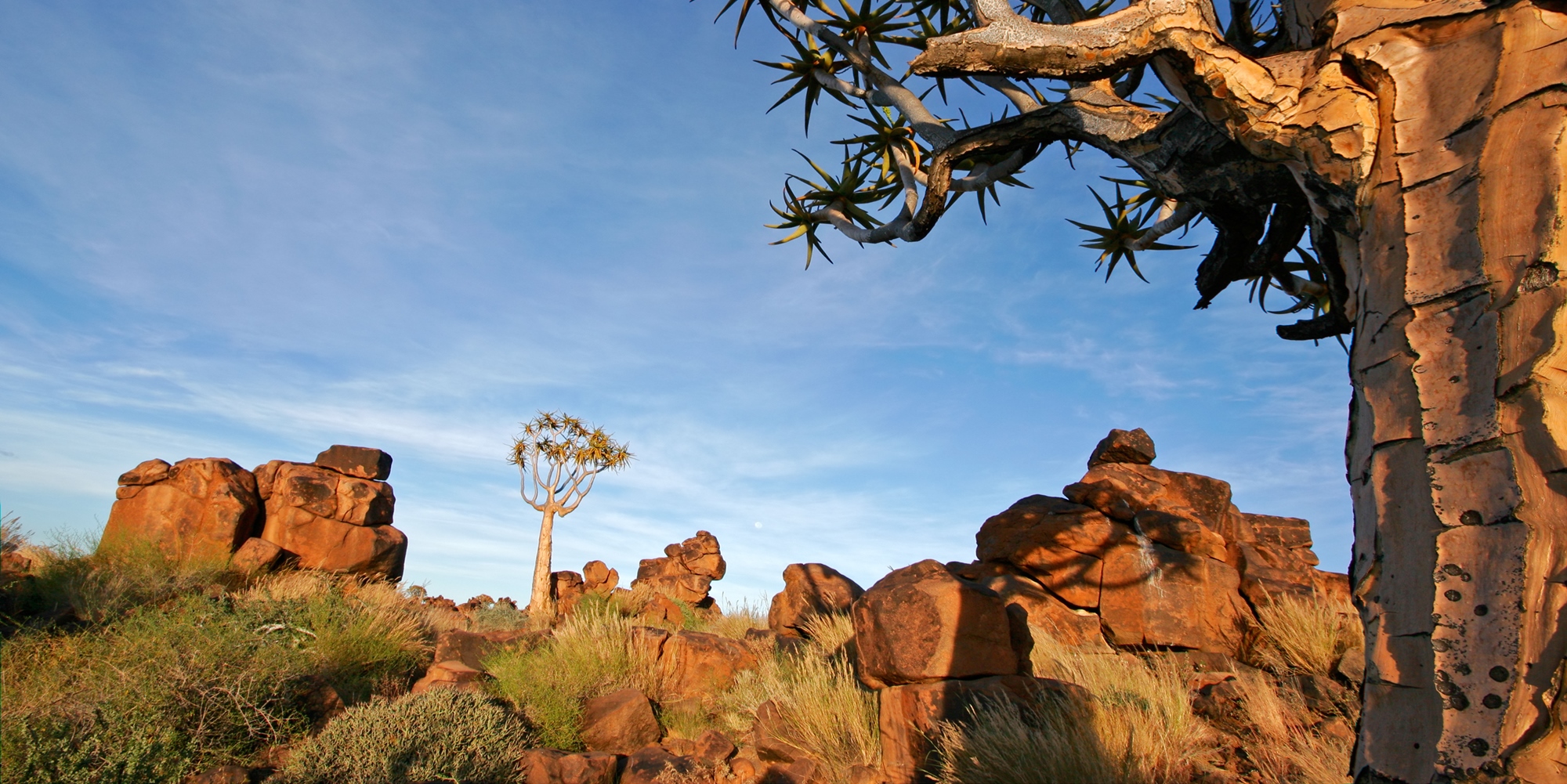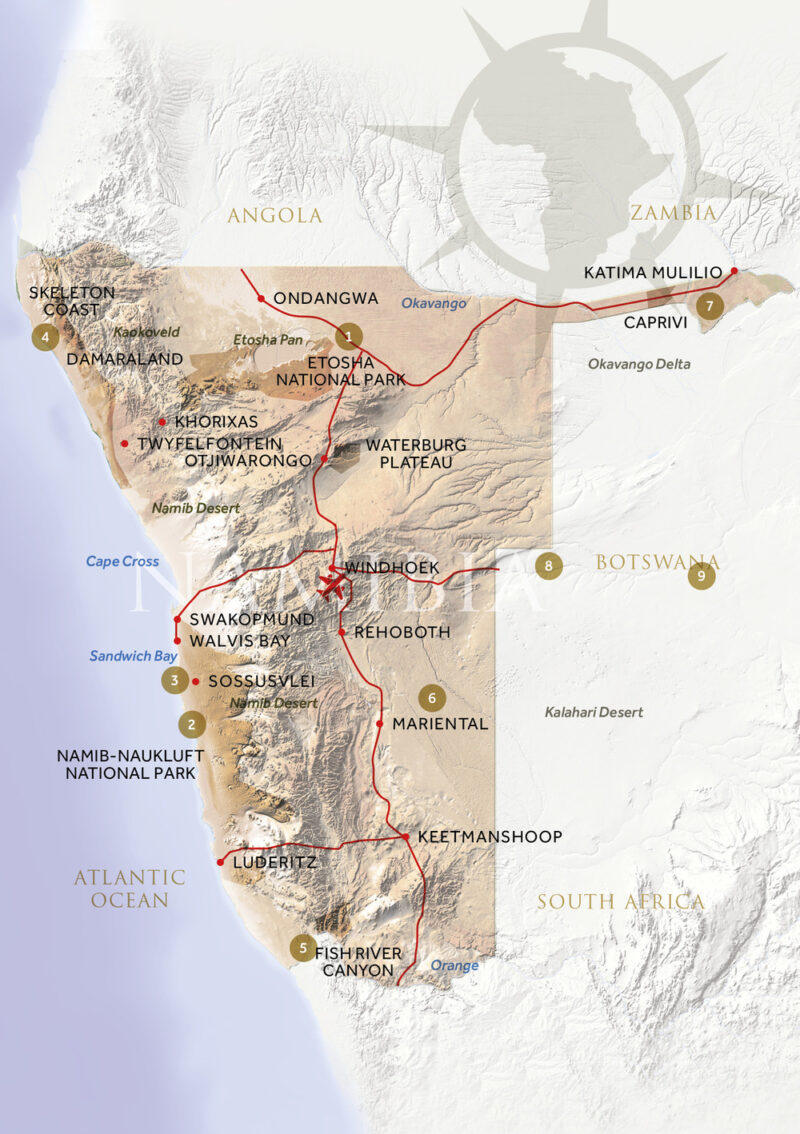
Namibia
From the towering sand dunes at Sossusvlei to the wild expanses of Etosha National Park with its teeming wildlife, Namibia’s rugged landscape will stay with you long after the holiday has ended. Here you’ll find the starkly beautiful Namib desert colliding with the crashing waves of the Atlantic as they pummel the Skeleton Coast. Inland, the petrified forests of Damaraland, ancient rock art sites, desert adapted elephants and black rhino await. Further south the dramatic Fish River Canyon begs exploration, a total contrast to the remote star studded Bushman land of the Kalahari which meets the lush Okavango wetlands spilling over Namibia’s north eastern border.
There are three ways to explore Namibia’s delights – you can self drive in a 4×4 vehicle, or you can enjoy a fly-in safari to some of the country’s most remote camps and lodges.
You’ll find a useful guide to Namibia and some of its attractions at the bottom of this page, along with a handful of sample safari journeys to inspire you. All our private safaris are tailor-made – there are many different combinations possible and we work with a multitude of camps and lodges and not just the ones shown in the sample tours. We are happy to suggest combinations using our personal knowledge and first-hand experience of these areas, but if you have a preferred lodge/camp please let us know. For price guides and further information please visit explorersagainstextinction.co.uk
Why Real Africa? We are one of the official partners of conservation charity Explorers Against Extinction which means when you book with us you are also supporting conservation.
We’re dedicated to offering you a personal service using only expert consultants with extensive first-hand knowledge and offering you financial protection through our partners for full peace of mind.
For suggested itineraries and price guides, visit our travel section at explorersagainstextinction.co.uk
Highlights of Namibia:
Caprivi Strip and Zambezi Region
Namib-Naukluft National Park and Namib Sand Sea
When To Go
You can expect beautiful dry weather from May with moderate temperatures, perfect for exploring, and a lush green landscape following the summer rains which fall December – March. June to October is dry, with temperatures rising. This is the peak time for wildlife which gathers around water sources. Night time temperatures often dip below freezing in desert areas. April and November are changeable months.
January – March
Be assured that the sun will shine on you whenever you visit Namibia as the country has an average of 300 sunny days a year. For those willing to put up with some rain as well, these months tend to be best value, with few visitors. Most rain showers only tend to last a short while before the clouds dissipate and sun shines once again bringing on a renewed vigour to the land.
The abundance of grass throughout the country means that herds of wildlife can be seen. Serious photographers often seek the contrast of green grass growing on the red sand dunes with the dramatic backdrop of thunderous skies.
After particularly good rains there are phenomena’s to see such as the lilies at Mariental and flamingos in the Etosha Pans. Migrating birds from Europe and elsewhere arrive thereby dramatically increasing the numbers of birds to be seen. If anyone is a birder in particular then the Caprivi is a fantastic area to visit during these months.
The coastal towns are particularly stunning due to the lack of winds and fog at this time of year and February is the best month for shark fishing, especially for the most sought after bronze whaler – this is all done on a catch and release basis.
April and May
A great time for photographers as the recent rain has cleared all the dust particles from the air making the atmosphere much clearer. The contrasts and colours in the landscapes are brought out to perfection. These months probably offer the best temperatures of the year with pleasant days and warm evenings. From April there is the chance of seeing the leather back turtle in the coastal waters. Apart from Easter, there aren’t that many people travelling so it isn’t too crowded.
June – September
The first two weeks of June are a fantastic time to make the most of flight deals and some economical accommodation prices before the high season begins, allowing those on a budget to get more for their money.
May and early June are great times for hiking before the busy season begins, whether it is in the Fish River Canyon, the Naukluft Mountains, the Waterberg Plateau or the Tok Tokkie Trail. The daytime temperatures aren’t too hot and the night temperatures not yet too cold when sleeping out. The rock pools in the Fish River Canyon and on the Naukluft trails still contain enough water for a nice dip.
This is a great time in terms of wildlife viewing. The longer grass will have been grazed making it much easier to spot wildlife on the open plains in Etosha. You can often see up to 7 different species at one of the waterholes at any one time.
August and early September are a particularly good time to travel down to the Fish River and Aus areas as the winter rains transform the landscape into a carpet of colours as all the flowers bloom. This area is sometimes known as the Namibian Namaqualand. It is always hard to pinpoint exactly when this is going to happen but it’s a spectacular sight for anyone who manages to time it right.
September is a great time to head into Damaraland as the elephant and other desert-adapted wildlife become easier to find as their water recourses begin to dry out. This area is famous for the largest free-roaming black rhino and desert elephant populations in the world, although we still advise that you come to Namibia for the landscape and not prolific wildlife whic tends to be elusive with the exception of Etosha of course.
October – December
If you are after animals in large numbers, visit Etosha in October. With scarce supplies of water during this season, the game is drawn to the permanent waterholes on the edge of the pan or at the main camps.
In October and even into November whales frequent the waters along the cost of Namibia, with possible sightings of humpback, southern right, Minke and even killer whales. Dolphins – both the bottlenose and the endemic Benguela (heavysides) – are present all year round, as are Cape fur seals.
During the second half of November and into December there is plenty of baby life to be seen. This is also the busiest time of year for the colony of breeding Cape Fur seals at Cape Cross, the largest of its kind in Southern Africa, when the sheer volume of seals is at its highest in December.
Definitely head down to Swakopmund on the coast to cool down in the Benguela ocean before exploring the town’s array of adventure sports, German architecture and cuisine and of course the nightlife there is on offer.
What To Do
The most famous natural wonder is the Namib desert, located in the Namib-Naukluft National Park. Here the huge sand dunes reach up to 300 metres in height and some have been measured at over 30 kilometres in length. They have had plenty of time to form – the Namib desert is the oldest desert in the world. A popular place to view the desert is at Sossusvlei where a salt pan is surrounded by these spectacular red dunes.
Running up much of the coast of Namibia is the bleakly names Skeleton Coast. This wild coastline is so named because of the number of wrecked ships and whale bones that are found on its shore. Ferocious winter storms, combined with plenty of fog has make it a shipping graveyard over the years, and if the sailors did make it ashore they were faced with a bleak and unforgiving landscape. The only inhabitants still are the large colonies of seals.
A great place to visit the coast is Swakopmund, a small town on Namibia’s west coast where both locals and travellers converge to explore and get away from the heat inland. Swakopmund has a quaint atmosphere with palm-lined streets, seaside promenades, art galleries and cafe culture. In the surrounding desert adventure seekers can try quad-biking, parasailing, sand-boarding and sand-skiing. Or relax at Walvis Bay on a kayak trip or dolphin cruise.
In the south of Namibia lies the Fish River Canyon, the second largest canyon in the world, over 90 kilometres long and in place over 500 metres deep. Its estimated that its taken the Fish River nearly 500 million years to erode it and is still going strong! A night at a lodge perched on its rim offers spectacular sunsets and rises.
For those wishing to safari then the most popular, and spectacular choice is Etosha National Park. This park contains a huge salt pan, offering a unique landscape in which to game-drive. The white landscape makes a great backdrop for the animals. To enjoy a safari you can either stay at Government lodges or chose one of the private lodges and camps that lie on the Park boundary. There is an excellent variety of game to be seen, including the Big Five.
For those who want something more remote then perhaps a stay in the Zambezi Region/Caprivi Strip, a thin finger of land that runs to the North of Botswana’s Okavango Delta. There is plenty of wetland here and by combining it with Etosha you get a superb mix of flora and fauna.
If you are interested in conservation we would also recommend a stay at Africat’s Okonjima in the Okonjima Reserve. For learning about and observing cheetah, Okonjima is fantastic. Close encounters with the animals are virtually guaranteed. There are four different types of accommodation on the reserve including the upmarket Grand African Villa (four rooms, exclusive use) which has the best position on the reserve, the luxury Bush Suites (two rooms), the mid-range Bush Camp (eight thatched safari chalets) and the more basic Plains Camp (20 rooms). Activities include game drives and walks with money from visitors funding this worthwhile project.
Why We Love
Namibia is like no other country in Africa. Despite being the home of several game reserves, including the world-famous Etosha National Park, it is its unique landscapes and cultures that are the main draw. Canyons, coastlines, deserts and dunes are what people come to see, making it a popular destination for those wanting to revisit Africa and see more than the wildlife.
